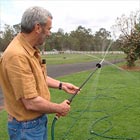In many parts of Australia the drought is starting to bite hard and water restrictions are in place. The restrictions will last until the rains come, which could be a long time. The most critical problem facing gardeners is water. Watering is a complex thing at the best of times, but it will be even more difficult if soils dry out over the long, hot summer. Even if the drought ends tomorrow, we will still face many months of problems with our garden soils.
Water repellent soil
When soils dry out they can become water repellent, or hydrophobic. When this happens, water just runs off instead of soaking into the soil. Water repellency is often caused by oils from decomposing matter. These oils wrap around soil particles and stop them from absorbing water.
Don showed a very good example of a hydrophobic soil. After watering a row of camellias for 15-20 minutes, he pulled back the mulch and found that the soil was dust dry underneath. Even turning the water on hard and pushing the nozzle into the soil didn’t help, because the dry soil just floated on top of the water! (Note: Don used dam water, not town water, for this demonstration.)
What to do
If water restrictions allow, install a drip irrigation system to deliver water exactly where it is needed most – at the roots. Apply a soil wetting agent such as Saturaid or Wettasoil (granular or soluble), to help moisture absorption into the soil. Don’t just water routinely – check soil before watering by putting your finger into the soil beyond the top 25mm (one inch) to see if it is already damp.
Further information
Drip irrigation systems are available from large garden centres and irrigation specialists.



